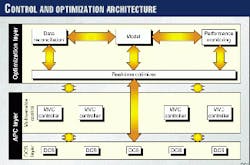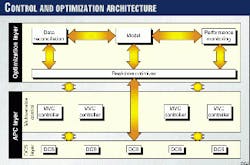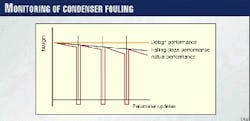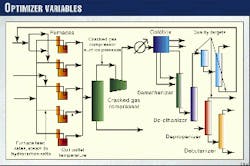Grangemouth ethylene plant installs closed-loop optimization solution
Grangemouth ethylene plant installs closed-loop optimization solution
BP Amoco, Grangemouth, UK, recently replaced the optimizer for one of its ethylene plants, named G4.
The project was completed in 4 months and will increase plant throughput by 3-4%/year.
The replacement for the G4 optimizer was required as a result of a major plant expansion (G4X). In addition, the replacement resolved year-2000 compliance issues with the existing distributed control system (DCS).
The expansion of the G4 site included a complete DCS replacement, increased use of advanced process control (APC), and real-time optimization (RTO) systems.
Fig. 1 illustrates how the optimization and APC layers work together.
Closed loop optimization is a valued and established technology at the BP Amoco Grangemouth site. The original G4 optimizer has been in operation for more than 8 years. Benefits from the original G4 optimizer are generally about £0.75 million/year. Also, G4's sister plant, called KG, has operated with an optimizer for more than 6 years.
BP Amoco chose MDC Technology's real-time optimization technology, RTO+, based on the success its application in the closed-loop optimization of the KG plant. The optimizer on G4's sister plant has been in continual use since its installation in 1993. It boasts average on-line times exceeding 90%.
BP Amoco set the following four objectives for the project:
- Minimize the period during which optimization is out of service as a result of process changes.
- Provide an accurate and robust process model of the G4 plant.
- Provide data links between the latest DCS technology and the G4X optimizer via MDC Technology's DXS (Data Xchange Server) utility.
- Provide full plant closed-loop optimization on a 10 min frequency.
The project was designed in two phases.
The first phase re-engineered the existing G4X process model. This was needed to simulate the expansion to the G4 plant and to provide online closed-loop optimization.
The second phase migrated the plant to the new DCS and APC systems. It combined the best aspects of RTO and APC to generate more benefits than either option alone.
G4X expansion
The G4 plant consisted of 13 furnaces attached to one of three feed headers: gas (ethane or propane), butanes, or liquid (naphtha). Twelve of these furnaces were old HGO4 furnaces, and one was a Lummus SRT furnace.
The quench tower, cracked-gas compression, and effluent separation areas are based upon a typical Stone & Webster Inc. design.
The expansion of the G4 site with the G4X project involved the following process changes:
- Installation of two new Stone & Webster Twin Cell Ultra Selective Conversion (USC) furnaces.
- Installation of a new C3 hydrogenation unit.
- Decommissioning of three of the existing HGO4 furnaces.
- Installation of a new cracked-gas compressor water-wash system, similar to the one installed on KG.
BP had an existing offline model for the G4 plant, which was used as the base point for the re-engineering of the G4X optimizer. This model was on the VAX/VMS platform. To gain a complete optimization solution, BP Amoco migrated the system to the latest version of RTO+, Version 2.3, which operates under Windows NT 4.0.
The integration of the process changes required a major overhaul of the existing model. Changes to the model were done before the October 1998 shutdown, when the process changes were incorporated into the plant.
When the plant came back on line 3 weeks later, the RTO+ model was ready for on site installation. Installation of the software and hardware, setting up the links to read live data from the plant, and subsequent commissioning of the on-line model were completed in 2 months.
Other aspects of the optimization system, such as data reconciliation and parameter updating, were also configured before commissioning of the system on site.
Software development
The RTO+ model's flexibility was demonstrated in its ability to accommodate an already trusted model that BP Amoco possessed.
Over the past years, the BP Amoco site at Grangemouth developed an in-house yield model to predict the furnace effluent. This model was based upon several input parameters developed over 3 decades of experience operating HGO4 furnaces.
As technology advanced, this yield model was incorporated into an asset-wide routine used to simulate all types of cracking furnaces used on the Grangemouth site, including the new USC furnaces on the G4 plant.
This Grangemouth yield model (GYM) uses several parameters to determine the mass fractions in the dry furnace effluent: feed type, feed rate per coil, dilution-steam rate, coil-outlet temperature (COT), coil-outlet pressure, and other physical quantities, such as coke thickness in the coils and the transfer line exchangers (TLXs).
After many years of use, the BP Amoco staff came to rely on this model. The staff used it for optimization, planning, and furnace modeling at the Grangemouth site. During the design phase for the G4X optimizer project, BP Amoco expressed a desire to continue using this model within the RTO+ infrastructure.
BP Amoco provided the GYM model as a Windows NT dynamic link library, which was easily incorporated into RTO+. Hence, the RTO+ process model is not limited to furnace modeling via MDC Technology's own furnace calculations; it can also simulate the furnace using GYM if desired.
This choice allows for greater flexibility than most other simulation systems.
Solution
The new system, as installed, consists of six on line processes, each running a different RTO+ model at different intervals. These processes are:
- A model process. This process performs data reconciliation and provides a simulation of the current plant performance. It also provides information about constraint and variable limits for the optimizer. This process runs every 5 min.
- The optimizer process. This process performs the online, closed-loop optimization of the G4 plant. It runs every 10 min.
- Three processes to keep the plant model tuned to current plant performance. These processes update parameters in the three compressor systems, the four main separation columns, and the feed-gas header. They run every 15 min.
- A severity process. While the RTO+ model of the furnace uses COT to determine the furnace effluent, the APC systems control the severity (methane to propylene ratio). This process uses the RTO+ model to generate gradients around the current point so that the DCS can correctly model the severity for the APC systems. It runs every 10 min.
The system installed takes data from the plant, via Honeywell's PHD (Process History Database) system, and transfers them into the six RTO+ processes via MDC Technology's DXS utility.
The data are processed and used in the models. The results are written back out to PHD and from there are implemented as setpoints for the existing controllers.
This asynchronous approach to optimization works by separating the different aspects so that each process can work independently of the others. This way, no one process depends on another having run. All the processes make use of a shared data storage area; in this case, PHD. Text files and shared computer memory are other means of sharing data between processes.
The model updating processes form part of the performance monitoring ability of RTO+. As the various columns and compressors are operated, a certain amount of fouling occurs that leads to a degeneration of performance.
RTO+ can help monitor the degradation over a period of time by adjusting certain key parameters to get a "best fit" to data taken over a long period of time. Fig. 2 shows an example of condenser fouling performance monitoring. In the case of a column, the Murphree efficiency is used to adjust the number of theoretical plates. For a condenser, an efficiency to adjust the UA value is used.
With each update of the parameters, the process model is pushed closer to how the plant is currently performing. Monitoring these parameters can give the users an idea of how the process has degraded over a long period of time.
The process model
The G4 plant is a typical Stone & Webster-designed ethylene plant with a well-defined sequential separation section. The RTO+ process model uses many standard unit model operations to simulate the G4 plant.
Optimizer variables are shown in Fig. 3. The following areas are covered in the model:
- Feed area. Various streams supply each of the three feed headers, such as Mossmorran ethane or Kinneil dry gas. Each of these headers is included in detail within the model to determine the composition of the feed to the furnaces.
- Furnaces. The furnaces are represented in the model by either BP Amoco's GYM routine or MDC Technology's proprietary furnace calculations. The TLX exchangers are included here to ensure an enthalpy balance across the area, as well as to determine the amount of EHP (extra high pressure) steam raised.
- Quench tower. The quench-tower area is modeled to determine the composition and flow to the cracked-gas compressors. An enthalpy balance over the quench area and the quench-water circuit is central to the model to determine the amount of primary quench water required.
- Cracked-gas compressor train. This compressor train generally forms the limiting constraints on the operation of the ethylene plant, so that the representation is necessarily more complex. Each of the compressor stages is modeled separately; each compressor stage has separate tuning factors to allow the model to more accurately match plant behavior.
- Coldbox and demethanizer. The coldbox area is very well specified in terms of available data. Because of this, the coldbox area is modeled extensively.
- De-ethanizer, C2 hydrogenation, and C2 splitter. The separation of the main products is modeled to determine the number of theoretical plates and the reflux ratio. The bottoms impurity specification of the ethylene splitter, the amount of ethylene in the ethane stream, can be used as an optimizer variable should the need arise.
- Depropanizer C3 hydrogenation, and debutanizer area. Many plant measurements were available for these areas. These data include quality analyses on the overheads and bottoms streams. These measurements formed the basis for modeling these areas.
The G4 plant shares a propane-propylene purification system with its sister plant, KG. For the purposes of the process model, the secondary de-ethanizer and C3 splitter columns are not included with the other separation sections because the feeds to these towers do not come solely from the G4 plant but from the KG plant as well.
The process model is a modular sequential model, which means that many of the internal recycles are not explicitly solved but are solved by the optimizer algorithm. The optimizer also performs the pressure balance along the C-1 compressor train.
The plant model will not necessarily match the plant exactly as a result of the dynamic nature of the plant. Also the model uses steady-state approximations to estimate plant operations.
The RTO+ system includes a proprietary constraint updating strategy to take account of any inconsistencies in the plant model. This allows the optimizer to contain a true representation of the process plant.
The model process sets up the limits for the variables and the constraints used by the optimizer. It also defines the base point to determine the incremental benefit provided by the optimizer. Data pass between the online processes via PHD and text files.
Optimizer process
The optimizer can be used in several ways: to solve the plant model, to provide on line, closed-loop optimization of the plant, and to develop "what if" off-line studies.
The scope for optimization on the G4 plant is fairly well defined. The optimizer variables are primarily concerned with the front end. The feed rates to each of the furnaces, the steam-to-oil ratio, and the COT are the handles with which the optimizer and the operators control the plant.
Also, for those furnaces on the gas header, the crossover temperature (XOT) is equally important.
Other variables included in the optimization problem are the C-1 suction pressure, which effectively controls the operation of the cracked gas compressor system, the propylene-refrigeration compressor suction pressure, and the "soft" targets on the de-ethanizer, C2 splitter, and depropanizer columns.
The suction pressure of the ethylene-refrigerant compressor is not included as an optimization variable because there are no physical means of implementing the setpoints on site.
Because the dynamics of the G4 plant are much slower than that of the KG plant, where the optimizer runs every 3 min, the optimizer can run at a much slower rate (every 10 min) and still capture the relevant behavior of the plant.
The intention is to allow the optimizer gently to nudge the plant towards the optimal position, given the current operating conditions. For closed-loop optimization on the G4X optimizer, a limited number of iterations are given. This limits the time that the optimizer takes to run. It also provides a quick answer that, while not optimal, tends towards it.
It was felt that 90% of the benefits in 50% of the time would be better than achieving the optimum. This way, the optimizer can still respond to disturbances without losing sight of the ultimate objective.
The objective function of the optimizer is an economic target constructed from the actual costs of the feed and the product prices. Utility costs are also taken into account.
These values are taken from the DCS where they can be kept up to date by the operators. This way, the optimizer can keep in touch with economic changes in the business.
Benefits
The benefits of the KG optimizer are generally reckoned to be around £1.5 million/year. Although the expansion project has closed the gap somewhat, G4 is still a smaller plant, and thus the benefits from the G4X optimizer are smaller.
While the incremental advantage per optimizer run will be small, the benefit generally associated with RTO is throughput increased by 3-4%/year.
Other benefits can be gained by use of the optimizer as an off-line "what if" tool. This can determine the worth of alternative operating conditions without disturbing current plant performance.
Second project phase
With the model complete, the second phase of the project migrated the plant to the new control systems.
RTO provides many benefits over APC alone, and vice versa. Although APC can capture the dynamics of an area, the model generated only encompasses a very small section of the overall process. By necessity, an APC model must be linear.
RTO provides the ability to simulate the whole plant with a nonlinear, sequential modular approach. Although these models are steady state, the nonlinear approach enables better approximations to the gradients of the plant. The goal of the second phase of the project was to combine the best aspects of both approaches to control the plant.
In the second phase of the project, different system architectures are in place. Data pass to RTO+ via the same mechanism; but rather than writing setpoints down to the controllers directly, the results are written as a set of ranges for a coordination layer.
This coordination layer then takes the set-ranges, generated by RTO+, and implements the set-ranges as controlled or manipulated variable range limits for the APC system. This is done in a coordinated fashion with respect to the process dynamics.
With RTO+, the steady-state approach has to be taken to enable swift response. Hence, this second layer takes the steady-state optimal set-ranges and incorporates the dynamic models of the controllers to generate a better response than either APC or RTO alone.
The coordination layer is also used as a conduit for the on line updating of process gains, where there is significant nonlinearity. The gradients are required to predict behavior around the current point, since the controllers do not have a complete and accurate model of the area, only a dynamic data-driven model. This enables the optimization to take place.
This is a two-way cooperative deal, however. The intention is for the APC systems to provide steady-state predictions for some of the back-end data so that the dynamics of the plant can be taken out of the steady-state RTO+ model. This, in turn, provides better approximations to the gradients, and enables the APC optimization to perform better.
The migration of all DCS functions to the PHD system will be complete in early 2000. Until then, the G4X optimizer will be the only optimization tool available to the operators.
The Authors
Douglas Prior is project engineer for MDC Technology Ltd., Teesside. He has worked for MDC Technology for 4 years. Prior has been involved in the construction and commissioning of several optimization systems for BP Chemical and BP Exploration. He led the G4X optimizer commissioning team.
Prior holds a bachelor's degree in chemical engineering from the University of Newcastle-Upon-Tyne, UK, and an MSc in computational mathematics from Teesside University, Middlesbrough, UK.
Simon Lopez is senior application engineer in the applied manufacturing technology (AMT) group at BP Amoco, Grangemouth, Scotland. He has worked for BP Chemicals for 10 years, the last 8 in the AMT group on advanced control and optimization projects. Lopez specializes in optimization systems and has been involved in the construction, commissioning, and subsequent operation of all the closed loop optimizers in use on the Grangemouth site.
Lopez holds a bachelor's degree in chemical engineering from Leeds University, UK.





